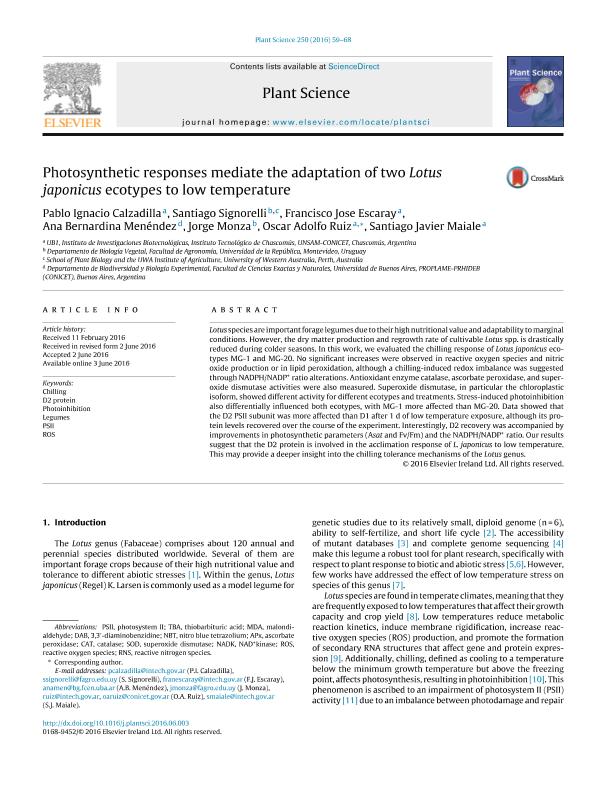Mostrar el registro sencillo del ítem
dc.contributor.author
Calzadilla, Pablo Ignacio

dc.contributor.author
Signorelli, Santiago
dc.contributor.author
Escaray, Francisco José

dc.contributor.author
Menendez, Ana Bernardina

dc.contributor.author
Monza, Jorge
dc.contributor.author
Ruiz, Oscar Adolfo

dc.contributor.author
Maiale, Santiago Javier

dc.date.available
2017-10-03T16:30:53Z
dc.date.issued
2016-06-03
dc.identifier.citation
Calzadilla, Pablo Ignacio; Signorelli, Santiago; Escaray, Francisco José; Menendez, Ana Bernardina; Monza, Jorge; et al.; Photosynthetic responses mediate the adaptation of two Lotus japonicus ecotypes to low temperature; Elsevier Ireland; Plant Science; 250; 3-6-2016; 59-68
dc.identifier.issn
0168-9452
dc.identifier.uri
http://hdl.handle.net/11336/25743
dc.description.abstract
Lotus species are important forage legumes due to their high nutritional value and adaptability to marginal conditions. However, the dry matter production and regrowth rate of cultivable Lotus spp. is drastically reduced during colder seasons. In this work, we evaluated the chilling response of L. japonicus ecotypes MG-1 and MG-20. No significant increases were observed in reactive oxygen species and nitric oxide production or in lipid peroxidation, although a chilling-induced redox imbalance was suggested through NADPH/NADP+ ratio alterations. Antioxidant enzyme catalase, ascorbate peroxidase, and superoxide dismutase activities were also measured. Superoxide dismutase, in particular the chloroplastic isoform, showed different activity for different ecotypes and treatments. Stress-induced photoinhibition also differentially influenced both ecotypes, with MG-1 more affected than MG-20. Data showed that the D2 PSII subunit was more affected than D1 after 1 d of low temperature exposure, although its protein levels recovered over the course of the experiment. Interestingly, D2 recovery was accompanied by improvements in photosynthetic parameters (Asat and Fv/Fm) and the NADPH/NADP+ ratio. Our results suggest that the D2 protein is involved in the acclimation response of L. japonicus to low temperature. This may provide a deeper insight into the chilling tolerance mechanisms of the Lotus genus.
dc.format
application/pdf
dc.language.iso
eng
dc.publisher
Elsevier Ireland

dc.rights
info:eu-repo/semantics/openAccess
dc.rights.uri
https://creativecommons.org/licenses/by-nc-sa/2.5/ar/
dc.subject
Chilling
dc.subject
D2 Protein
dc.subject
Photoinhibition
dc.subject.classification
Bioquímica y Biología Molecular

dc.subject.classification
Ciencias Biológicas

dc.subject.classification
CIENCIAS NATURALES Y EXACTAS

dc.title
Photosynthetic responses mediate the adaptation of two Lotus japonicus ecotypes to low temperature
dc.type
info:eu-repo/semantics/article
dc.type
info:ar-repo/semantics/artículo
dc.type
info:eu-repo/semantics/publishedVersion
dc.date.updated
2017-08-07T18:42:01Z
dc.identifier.eissn
1873-2259
dc.journal.volume
250
dc.journal.pagination
59-68
dc.journal.pais
Irlanda

dc.journal.ciudad
Shannon
dc.description.fil
Fil: Calzadilla, Pablo Ignacio. Consejo Nacional de Investigaciones Científicas y Técnicas. Centro Científico Tecnológico Conicet - La Plata. Instituto de Investigaciones Biotecnológicas. Instituto de Investigaciones Biotecnológicas "Dr. Raúl Alfonsín" (sede Chascomús). Universidad Nacional de San Martín. Instituto de Investigaciones Biotecnológicas. Instituto de Investigaciones Biotecnológicas "Dr. Raúl Alfonsín" (sede Chascomús); Argentina
dc.description.fil
Fil: Signorelli, Santiago. Universidad de la República; Uruguay. University of Western Australia; Australia
dc.description.fil
Fil: Escaray, Francisco José. Consejo Nacional de Investigaciones Científicas y Técnicas. Centro Científico Tecnológico Conicet - La Plata. Instituto de Investigaciones Biotecnológicas. Instituto de Investigaciones Biotecnológicas "Dr. Raúl Alfonsín" (sede Chascomús). Universidad Nacional de San Martín. Instituto de Investigaciones Biotecnológicas. Instituto de Investigaciones Biotecnológicas "Dr. Raúl Alfonsín" (sede Chascomús); Argentina
dc.description.fil
Fil: Menendez, Ana Bernardina. Consejo Nacional de Investigaciones Científicas y Técnicas. Oficina de Coordinación Administrativa Ciudad Universitaria. Instituto de Micología y Botánica. Universidad de Buenos Aires. Facultad de Ciencias Exactas y Naturales. Instituto de Micología y Botánica; Argentina
dc.description.fil
Fil: Monza, Jorge. Universidad de la República; Uruguay
dc.description.fil
Fil: Ruiz, Oscar Adolfo. Consejo Nacional de Investigaciones Científicas y Técnicas. Centro Científico Tecnológico Conicet - La Plata. Instituto de Investigaciones Biotecnológicas. Instituto de Investigaciones Biotecnológicas "Dr. Raúl Alfonsín" (sede Chascomús). Universidad Nacional de San Martín. Instituto de Investigaciones Biotecnológicas. Instituto de Investigaciones Biotecnológicas "Dr. Raúl Alfonsín" (sede Chascomús); Argentina
dc.description.fil
Fil: Maiale, Santiago Javier. Consejo Nacional de Investigaciones Científicas y Técnicas. Centro Científico Tecnológico Conicet - La Plata. Instituto de Investigaciones Biotecnológicas. Instituto de Investigaciones Biotecnológicas "Dr. Raúl Alfonsín" (sede Chascomús). Universidad Nacional de San Martín. Instituto de Investigaciones Biotecnológicas. Instituto de Investigaciones Biotecnológicas "Dr. Raúl Alfonsín" (sede Chascomús); Argentina
dc.journal.title
Plant Science

dc.relation.alternativeid
info:eu-repo/semantics/altIdentifier/url/http://www.sciencedirect.com/science/article/pii/S0168945216301029
dc.relation.alternativeid
info:eu-repo/semantics/altIdentifier/doi/http://dx.doi.org/10.1016/j.plantsci.2016.06.003
Archivos asociados
